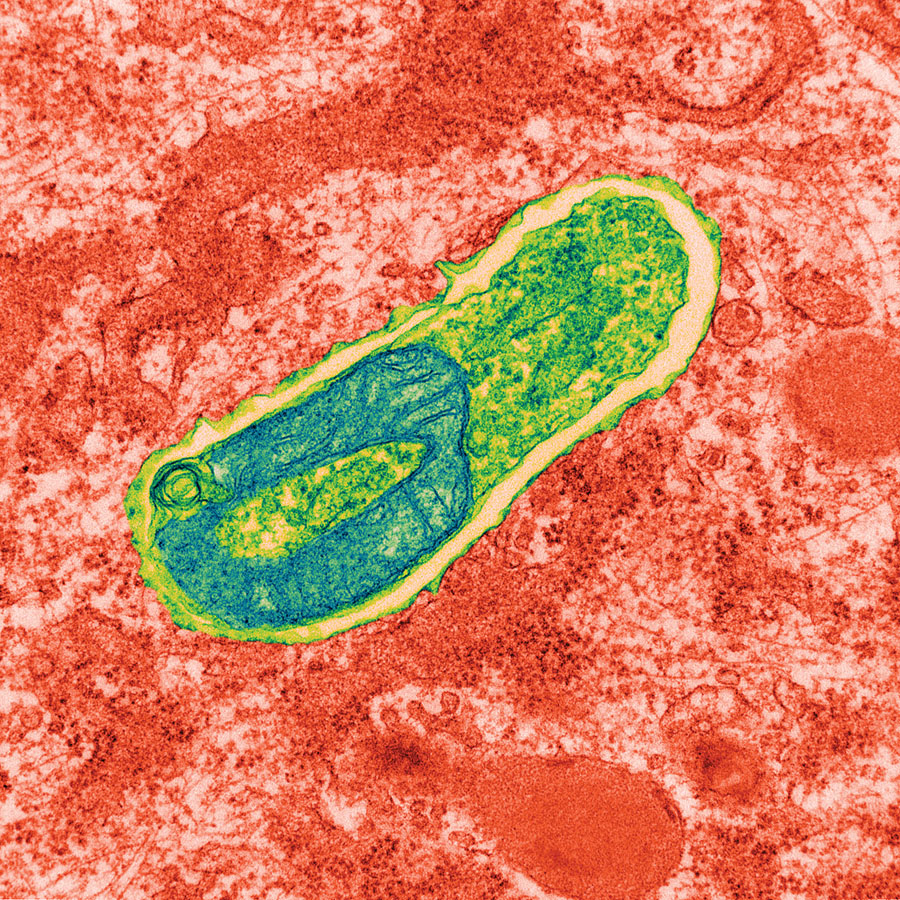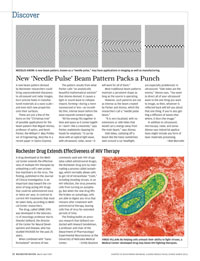In Review
 NEEDLES KNOW: A new beam pattern, known as a “needle pulse,” may have applications in imaging as well as manufacturing. (Photo: Courtesy of Kevin Parker and Miguel Alsonso)
NEEDLES KNOW: A new beam pattern, known as a “needle pulse,” may have applications in imaging as well as manufacturing. (Photo: Courtesy of Kevin Parker and Miguel Alsonso)A new beam pattern devised by Rochester researchers could bring unprecedented sharpness to ultrasound and radar images, burn precise holes in manufactured materials at a nano scale—and even etch new properties onto their surfaces.
These are just a few of the items on the “Christmas tree” of possible applications for the beam pattern that Miguel Alonso, professor of optics, and Kevin Parker, the William F. May Professor of Engineering, describe in a recent paper in Optics Express.
The pattern results from what Parker calls “an analytically beautiful mathematical solution” that Alonso devised. It causes a light or sound wave to collapse inward, forming—during a mere nanosecond or less—an incredibly thin, intense beam before the wave expands outward again.
“All the energy fits together in time and space so it comes together—bam!—like a crescendo,” says Parker, explosively clapping his hands for emphasis. “It can be done with an optical light wave, with ultrasound, radar, sonar—it will work for all of them.”
Most traditional beam patterns maintain a persistent shape as long as the source is operating.
However, such patterns are not as intense as the beam created by Parker and Alonso, which the researchers call a “needle pulse beam.”
“It is very localized, with no extensions or side lobes that would carry energy away from the main beam,” says Alonso.
Side lobes, radiating off a beam like the halos sometimes seen around a car headlight, are especially problematic in ultrasound. “Side lobes are the enemy,” Alonso says. “You want to direct all of your ultrasound wave to the one thing you want to image, so then, whatever is reflected back will tell you about that one thing. If you’re also getting a diffusion of waves elsewhere, it blurs the image.”
In addition to ultrasound, microscopy, radar, and sonar. Alonso says industrial applications might include any form of laser materials processing.
—Bob Marcotte
 VIRUS VILLAIN: By helping cells unleash their ability to fight viruses, a Medical Center–developed drug may boost HIV-fighting therapies. (Photo: Science Source)
VIRUS VILLAIN: By helping cells unleash their ability to fight viruses, a Medical Center–developed drug may boost HIV-fighting therapies. (Photo: Science Source)Rochester Drug Extends Effectiveness of HIV Therapy
A drug developed at the Medical Center extends the effectiveness of multiple HIV therapies by unleashing a cell’s own protective machinery on the virus. The finding, published in the Journal of Clinical Investigation, is an important step toward the creation of long-acting HIV drugs that could be administered once or twice per year, in contrast to current HIV treatments that must be taken daily, according to Medical Center researchers.
The drug, called URMC-099, was developed in the laboratory of neurology professor Harris (Handy) Gelbard, the director of the Center for Neural Development and Disease, who has studied HIV/AIDS for the past 25 years.
When combined with “nanoformulated” versions of two commonly used anti–HIV drugs (also called antiretroviral drugs), the Rochester drug acts by interrupting a process called autophagy, which normally allows cells to get rid of intracellular “trash,” including invading viruses. In an HIV infection, the virus prevents cells from turning on autophagy. But when the new drug lifts the brakes on autophagy, cells are able to digest any virus that remains after treatment with antiretroviral therapy, leaving cells free of virus for extended periods of time.
The finding builds on previous research that Gelbard conducted with Howard Gendelman, a professor and chair of the Department of Pharmacology/Experimental Neuroscience at the University of Nebraska Medical Center. —Emily Boynton
 HOW MANY MONKEYS? New Rochester research indicates that rhesus monkeys and other primates can use numbers to estimate amounts. (Photo: Frank and Joyce Burek/National Geographic Creative)
HOW MANY MONKEYS? New Rochester research indicates that rhesus monkeys and other primates can use numbers to estimate amounts. (Photo: Frank and Joyce Burek/National Geographic Creative)Knowing Numbers: A Primate Ability?
Several primate species may be able to use numbers to estimate amounts, according to the latest work of a Rochester lab that’s long been exploring how humans develop concepts such as simple counting and complex mathematical reasoning.
In a study published in the journal Nature Communications, the team of Jessica Cantlon, associate professor of brain and cognitive sciences, PhD candidate Steve Ferrigno, Steven Piantadosi, an assistant professor of brain and cognitive sciences, and Julian Jara-Ettinger, a postdoctoral researcher in brain and cognitive sciences at MIT, compared number perception for a single task that was performed across a diverse testing population. The results suggest that primates have the ability to distinguish large and small quantities of objects, irrespective of the surface area they appear to occupy.
The new work follows earlier studies led by Cantlon who, early in her career at Rochester, began studying primates in a search for the origins of numeric understanding. In 2013, she, Ferrigno, and colleagues at Rochester and Rochester’s Seneca Park Zoo made a surprising discovery: in an experiment using varying quantities of peanuts, baboons (even as young as one year of age) clearly showed an ability to distinguish between large and small quantities of objects.
But the finding raised another question. To what extent might that ability be influenced by other dimensions of those objects—such as their relative surface area—in addition to their number?
For the new study, the group looked at both humans and primates: adults and children in the United States; adults of the Tsimane’, a predominately “low numeracy” cultural group that inhabits an area of remote rain forest in Bolivia, and that has been long studied by Piantadosi and Jara-Ettinger; and rhesus monkeys, a species with strong neural and cognitive similarities to humans.
The researchers found that all groups showed a bias toward numbers over surface area in their estimations.
“This shows that the spontaneous aspect of extracting numerical information likely has an evolutionary basis, because this has been seen across all humans and also with other primate species,” says Ferrigno.
The study also showed that the bias toward the numerical dimension was strongest in humans compared to primates, and was correlated with increasing age and math education in humans.
—Bob Marcotte
‘Chemo-brain’ Is Pervasive, Study Shows
The largest study of a condition known as “chemo-brain” shows that women with breast cancer report it’s a substantial problem after chemotherapy for as long as six months after treatment, according to investigators at the Wilmot Cancer Institute.
Scientists have known that cancer-related cognitive impairment, which includes problems with memory, attention, and processing information, is an important issue for patients. Yet previous studies have left questions about when and why it occurs and who is most likely to develop the condition.
Led by Michelle Janelsins, an assistant professor of surgery in Wilmot’s Cancer Control and Survivorship Program, and published in the Journal of Clinical Oncology, the new study compared 581 breast cancer patients treated at clinical sites across the United States and 364 healthy people, with a mean age of 53 years in both groups. Using a well-validated measurement of impairment, investigators found that compared to healthy people, the scores of women with breast cancer exhibited 45 percent more impairment. Over a period of nearly a year, 36.5 percent of women reported a decline in scores compared to 13.6 percent of the healthy women.
—Leslie Orr
Building a Better Microbial Fuel Cell—with Paper
Researchers at the University have made significant progress toward using bacteria to generate an electrical current, a century-old concept known as a microbial fuel cell.
In work published in ACS Energy Letters, Kara Bren, a professor of chemistry, and Peter Lamberg, a postdoctoral fellow, report that they have developed an efficient electrode for a fuel cell that relies on bacteria found in wastewater by using a new preparation of a common household material: paper.
The breakthrough is important because the new electrode is less prone to corrosion and clogging than previous methods.
Until now, most electrodes used in wastewater have consisted of metal, which rapidly corrodes, or carbon felt. While the latter is the less expensive alternative, carbon felt is porous and prone to clogging.
Bren and Lamberg’s solution was to replace the carbon felt with paper coated with carbon paste, which is a simple mixture of graphite and mineral oil. The carbon paste-paper electrode is not only cost-effective and easy to prepare, but also outperforms carbon felt.
In making their electrode, Bren and Lamberg created a layered sandwich of paper, carbon paste, a conducting polymer, and a film of the bacteria. The paper electrode had an average output of 2.24 amps per unit area, compared to 0.94 with the felt anode.
“We’ve come up with an electrode that’s simple, inexpensive, and more efficient,” says Lamberg. “As a result, it will be easy to modify it for further study and applications in the future.”
—Peter Iglinski

